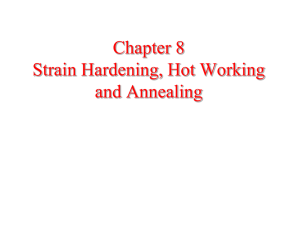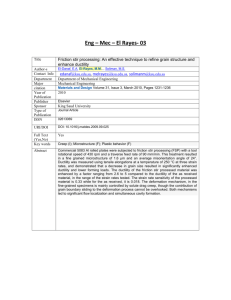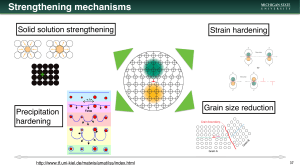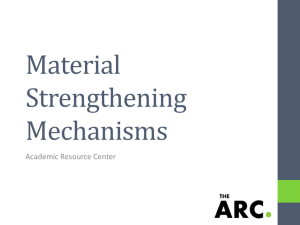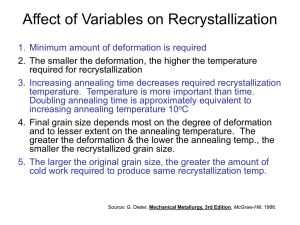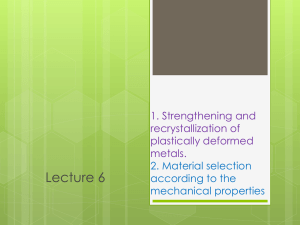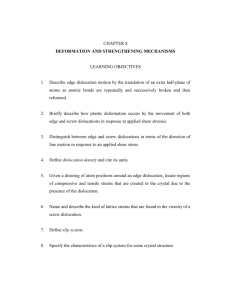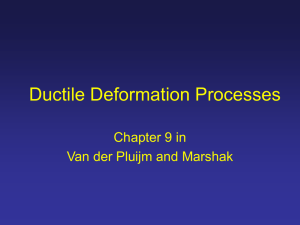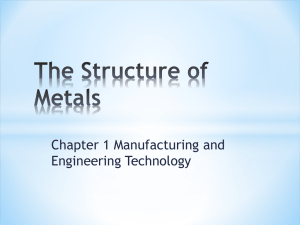Day_7 - Rose
advertisement
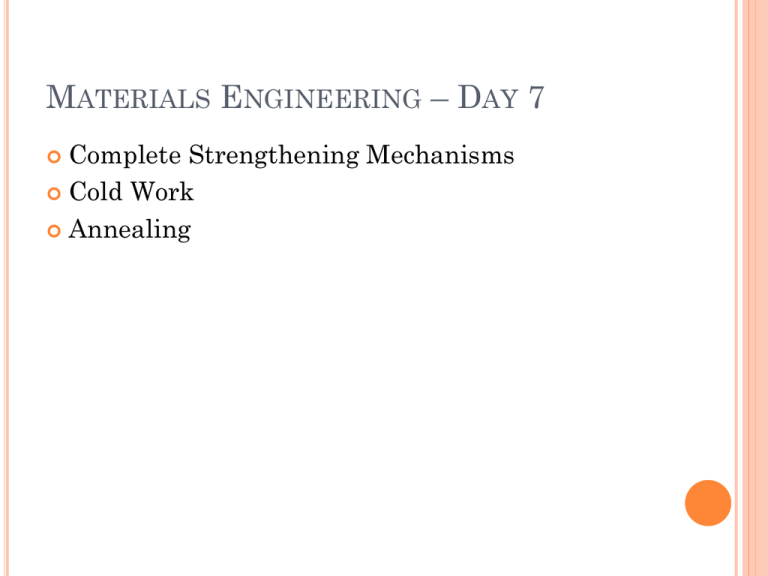
MATERIALS ENGINEERING – DAY 7 Complete Strengthening Mechanisms Cold Work Annealing SOLID SOLUTION STRENGTHENING AND GRAIN SIZE REFINEMENT Why are alloys stronger than the base metal alone? What is the advantage of having a fine-grained crystalline structure? THE HALL-PETCH RELATIONSHIP Yield Strength sys =so+kyd-1/2 d -1/2 Effect of Grain Size Reduction EXAMPLE Assume that a metal has a yield stress of 20 ksi if the grain size is 10-4 mm, and 32 ksi if the grain size is 10-6 mm. What will be the yield stress if the grain size was 10-5 mm, all other things being equal? 20 0 k 10000 Solving, we find that k=0.01333 and 0 = 18.67 32 0 k 1000000 y 18.67 0.01333 100000 22.9 ksi ANOTHER BLOCKER: OTHER DISLOCATIONS Recall that as plastic deformation proceeds the density of dislocations increases by several orders of magnitude. So dislocations block each other. This accounts for the strengthening that occurs during plastic deformation. (Done on purpose, we call it cold work. Yield Strength Degree of strengthening depends on material %area reduction Effect of Plastic Deformation WHAT ABOUT DUCTILITY? A trade off is taking place. As we block dislocations, and the material gets stronger, we lose the capacity for plastic deformation. In other words, the ductility is decreased. AS WE BLOCK DISLOCATIONS, STRENGTH INCREASES AND DUCTILITY DECREASES. Exception: Fine grain size gives strength without significant decrease in ductility. FOR COLD WORK AND ANNEALING BE ABLE TO: Calculate %cold work from change in crosssectional geometry Describe the microstructural and property changes during Recovery, Recrystallization and Grain Growth, and the relationship between microstructure and properties COLD WORK In cold work, metals are strengthened at the expense of ductility. Cold refers to the fact that the material is plastically deformed at a temperature below it “recrystallization” temperature. (More on this later.) Also called strain hardening. A0 Rolling: very common CW Af okasatria.blogspot.com/ The grain structure of a low carbon steel produced by cold working: (a) 10% cold work, (b) 30% cold work, (c) 60% cold work, and (d) 90% cold work (250). (Source: From ASM Handbook Vol. 9, Metallography and Microstructure, (1985) ASM International, Materials Park, OH 44073. HOW COLD WORK IS MEASURED It is measured as the percentage in area reduction during the deformation process. %CW A0 Af A0 100% This is calculated in the same way that %RA ductility is calculated. BUT, the CW produced in some manufacturing process, not the tension test. 4 STRATEGIES FOR STRENGTHENING: 4: COLD WORK (%CW) • Room temperature deformation. • Common forming operations change the cross sectional area: -Forging force die A o blank -Drawing die Ao -Rolling Ad Ao Adapted from Fig. 11.8, Callister 7e. Ad roll force Ad roll -Extrusion Ao tensile force force die container ram billet container Ao Ad %CW x 100 Ao die holder Ad extrusion die 11 DISLOCATIONS DURING COLD WORK • Ti alloy after cold working: • Dislocations entangle with one another during cold work. • Dislocation motion becomes more difficult. 0.9 mm Adapted from Fig. 4.6, Callister 7e. (Fig. 4.6 is courtesy of M.R. Plichta, Michigan Technological University.) 12 RESULT OF COLD WORK Dislocation density = total dislocation length unit volume Carefully grown single crystal ca. 103 mm-2 Deforming sample increases density 109-1010 mm-2 Heat treatment reduces density 105-106 mm-2 • Yield stress increases as rd increases: y1 y0 large hardening small hardening e 13 IMPACT OF COLD WORK As cold work is increased • Yield strength (y) increases. • Tensile strength (TS) increases. • Ductility (%EL or %AR) decreases. Adapted from Fig. 7.20, Callister 7e. 14 WHY DO COLD WORK… It’s about several issues… 1. Strengthening the manufactured part 2. Shaping the manufactured part 3. Cold Work can be used to impart a nice surface finish Often we can’t complete the shaping process with just one step of cold work. There just isn’t enough ductility in the metal. Plus, we need to get the material back to a state of 0% CW. (While keeping the new shape, of course!) How might we do that? First, think of what we have. WHAT COLD WORKED METAL IS LIKE Dislocation density very high. Residual stresses are very commonly encountered. The original grain structure is still in existence. But the grains have been stretched in the direction of the deformation. Electrical conductivity and thermal conductivity may be reduced. The state of internal energy is high. So what can be done to diminish these effects? ANNEALING 1. 2. 3. Annealing – a thermal process – we heat the cold worked metal. BUT WE DO NOT MELT IT Three phenomena are observed. Here is the order in which they are known to happen. Recovery. Enough energy is supplied so that dislocations can spontaneously move to lower residual stresses. Recrystallization. In the middle of the old, elongated grains, new small equi-axed grains begin to form, until we have a completely new grain structure. Grain growth. If more heat is supplied over time the grains grow, smaller ones eaten by bigger ones. FIGURES FROM TEXT SHOWING THE RECRYSTALLIZATION SEQUENCE. (BRASS – 33% CW) HEAT TO 580C. start After 8 s After 3 s After 15 min After 4 s After 10 min at 700C HERE’S HOW THE PROPERTIES CHANGE AS CHANGE ANNEALING TEMPERATURE Metal is Brass. This is based on an annealing time of 1 hour. Similar looking plots could be produced for a constant temperature with time as the independent variable. http://info.lu.farmingdale.edu/depts/met/met205/annealingstages.html “LAWS” OF RECRYSTALLIZATION Thermally activated. Critical temperature. Critical deformation. Deformation affects the critical temperature. Initial grain size affects the critical temperature. Grain boundaries are good sites for nuclei to form. RECRYSTALLIZATION TEMPEPATURE Depends on Alloy Content. Lower for pure metals. Depends on the amount of previous CW. Metal is iron (Fe). Note that for less than about 5% CW, there will be no recrystallization. Final note: Recrystallization is very useful in grain size control. REVIEW OF THREE STRENGTHENING MECHANISMS 1. 2. 3. Solute Atoms. (Alloying) Grain boundaries. (Grain boundary refinement) Dislocations. (Cold Work, i.e. plastic deformation done on purpose. THERE ARE OTHER STRENGTHENING MECHANISMS WHICH WE WILL ALSO TALK ABOUT.

